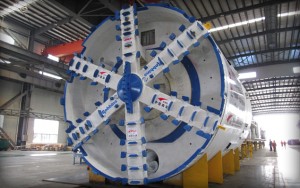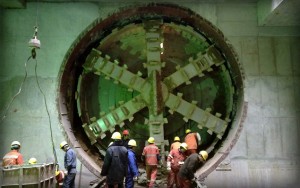![65 Years of Innovation and Experience [default]](https://www.robbinstbm.com/wp-content/uploads/2017/04/Side-Bar-Blue-Blocks_70-Years.jpg)
A Solution for Every Condition: Search our Project Database
Project Map
FEATURED PRODUCT: CROSSOVER MACHINES
Our History
A Legacy of Innovation
Information 24/7
News & Media
Insights in the Industry:
Read the Robbins Blog
 In June and July 2010, commencement of Xi’an’s Metro Line 1 began with the launch of two Robbins machines from Changlepo towards Wanshou Road Station—the first TBMs tunneling on the project.
In June and July 2010, commencement of Xi’an’s Metro Line 1 began with the launch of two Robbins machines from Changlepo towards Wanshou Road Station—the first TBMs tunneling on the project.
Xi’an’s 26.4 km metro Line 1 will run from north to south through the downtown area. Ten TBMs, including two 6.2 m diameter Robbins EPBs, excavated the new rail route. The route travels directly below some of the 3,100 year old city’s most sensitive heritage sites, including the terra cotta warriors.
The Robbins EPBs excavated Lot 12 of Line 1 for the 11th Bureau of China Railway Construction Corporation (CRCC). The parallel 3.6 km tunnels pass through four cut and cover station sites—Changlepo, Wanshou Road, Kangfu Road, and Jinhua Road—under shallow cover ranging from 8 to 22 m. The two TBMs were the first to start excavation on Line 1, and were followed by eight other machines excavating their respective lots.
A total supply contract was signed with China Railway 11th Engineering Bureau Group Limited in June 2009. The second machine assembly was completed in April 2010 at a nearby manufacturing facility in Chengdu before being shipped to the jobsite.
Both Robbins machines were optimized for geology including sand, abrasive pebbles and clay with significant ground water. Spoke-type cutterheads and 800 mm (32 in) diameter shaft-type screw conveyors aided in efficient advance while maintaining a water-tight seal and balanced pressure.
 The Lot 12 section was located in a densely urban area, with the tunnels traveling below a college, a hospital, and a marketplace. Crews continuously monitored the excavation rate and overall muck removal volume, by adjusting the thrust force, advance rate, and screw conveyor speed, while keeping the cutterhead speed low, at 1 rotation per minute. Sections of collapsible, water bearing soils were also present in early sections of the tunnel alignment. Crews approached these sections with similar measures, including strict earth pressure control in the mixing chamber, paired with injection of bentonite and water for soil conditioning.
The Lot 12 section was located in a densely urban area, with the tunnels traveling below a college, a hospital, and a marketplace. Crews continuously monitored the excavation rate and overall muck removal volume, by adjusting the thrust force, advance rate, and screw conveyor speed, while keeping the cutterhead speed low, at 1 rotation per minute. Sections of collapsible, water bearing soils were also present in early sections of the tunnel alignment. Crews approached these sections with similar measures, including strict earth pressure control in the mixing chamber, paired with injection of bentonite and water for soil conditioning.
Tunnelling was made even more complex by a city-wide ordinance limiting settlement to ± 15 mm; significantly less than the 25 mm limit that is typical of most Chinese tunnelling projects. The strict settlement guidelines, implemented out of caution due to the ancient structures, required specialized designs for the two Robbins EPBs.
The last intermediate breakthrough, at Jinhua Road station, occurred on July 28, 2011. Advance rates for the Left Line EPB were good—up to 579 m (386 rings) per month and 36 m (24 rings) per day. Planned maintenance was performed while in the cut and cover area, such as changing of cutters and tail seal brushes as well as checkups of the hydraulic system and electrical system. Semi-segment rings consisting of the invert and two segments were installed to allow the machine to ‘walk’ through the 140 m long station site.
Advance rates for the Right Line machine were similarly high—up to 453 m (302 rings) per month and 39 m (26 rings) per day. Settlement was kept below 15 mm with an average settlement of 5 mm.
By summer 2011, one machine had recently completed its second section of tunneling between Wanshou Road and Jinhua Road, and the other was on its last section between Jinhua Road and Kangfu Road in layered loess conditions.
The machines completed tunneling within the project schedule in the last quarter of 2011.

 Close
Close